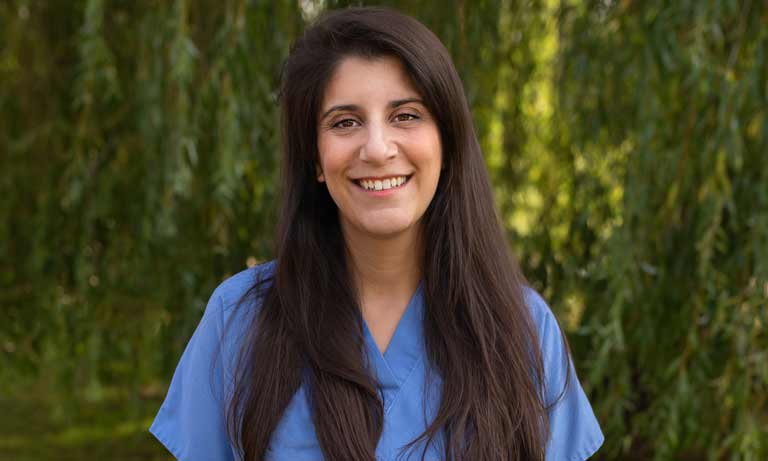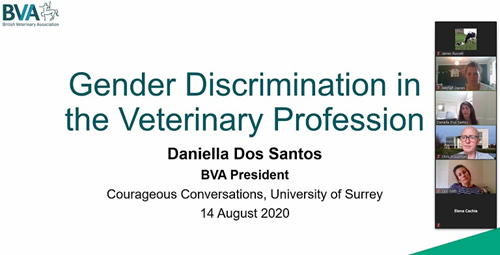Standing up for the veterinary profession
08 Aug 2024
02 Sep 2020 | Daniella Dos Santos
BVA President Daniella Dos Santos shares her experience speaking at the first dedicated diversity conference for the veterinary profession.

As someone whose presidential theme is #VetDiversity, the opportunity to attend a dedicated two-day conference on all things veterinary diversity was too good to miss. So I was absolutely delighted to join around 300 veterinary professionals last month at the UK’s first dedicated diversity conference, ‘Courageous Conversations’ – the Surrey virtual veterinary diversity conference held in partnership with the British Veterinary Ethnicity and Diversity Society (BVEDS).
The event was designed to facilitate open discussions around the challenges and potential solutions when it comes to diversity and inclusion within our profession. The programme included contributions from representatives of various support groups and professional associations, as well as individual vets and students, with one day being led by veterinary students. Crucially, the whole event had an overwhelmingly open and supportive atmosphere.

Workshops led by members of BVEDS, BVLGBT+, BVCIS, and AVS explored challenges faced by different groups and individuals and discussed how the profession could work together to ensure everyone is included and able to perform to their best. For many attending it was an opportunity to share experiences. For everyone attending it was about learning to be an ally. That is, using our own positions of privilege to listen and learn, to amplify the voices of our colleagues, and to take the time to educate ourselves. None of us faces the same challenges as others and so there was something for every delegate to learn.
I helped to lead two sessions. First of all I joined Chris Proudman, head of Surrey Vet School, to discuss gender diversity and discrimination in the veterinary profession, with a focus on the Athena Swan Charter which helps institutions achieve gender equality. Chris’s presentation included acknowledging the value of the programme, but also the importance of buy in from everyone to instigate change and the challenges in doing so. This is reflected in BVA’s own studies, where those who did not think gender discrimination was still a problem were more likely to discriminate against women: an example of unconscious bias.
As a starting point for any change, we all need to recognise and mitigate our own biases. I would urge everyone to take a test to assess their own unconscious biases and the Harvard Implicit Association Tests are a very good place to start.
A theme of the two days was developing our understanding that there can be multiple factors at work when people experience discrimination or barriers to entering the profession – the concept of intersectionality. The session that was programmed to discuss gender ended up highlighting the complex intersectionality of diversity, and the hard work we need to do in supporting colleagues and young aspiring vets who face multiple challenges.
Changing the demographics of the profession is about increasing diversity, a process that is exceptionally hard with various factors at play. We know that the demographics of the profession broadly reflect those who apply to vet school, and so we need to look at what’s happening in terms of the opportunities available long before young people start applying to vet school.
The decreasing number of men entering the veterinary profession was highlighted, but we know from research by UCL that the question shouldn’t be “where are all the men?” but “where are all the working-class men?” Young middle-class men don’t face barriers to applying to vet school; they simply choose not to. But there is a whole group of boys who don’t even consider a veterinary career – namely those from working class and ethnic minority backgrounds. And from a diversity and inclusion point of view, that is what we should be worried about.
The keynote speech from Stephanie-Rae Flicker from Animal Aspirations highlighted the incredible work students are currently doing to spearhead change, and I would encourage you to take a look at their work.
The second session I was involved in explored BVA’s new Good Veterinary Workplaces policy, which is fundamentally about how we ensure inclusion in the profession across all veterinary workplaces. The policy covers a wide range of areas and I so focused my presentation on the diversity chapter. The enthusiasm from all those taking part was hugely encouraging, and it is clear this piece of work has the potential to positively change our profession. I hope it will provide the tools for all of us to come together to share resources and ideas in order to facilitate that change. Please look out for the launch in September.
This incredible conference was truly inspirational. It was a must for anyone wanting to learn more about diversity and inclusion and allyship, and the excellent digital delegate bag provided links to useful resources to encourage attendees to continue educating themselves. If you missed it, the good news is that sessions are available online to watch back – please email [email protected] to access the links.
It is #TimeForChange and these courageous conversations have taken us one step further.
Get tailored news in your inbox and online, plus access to our journals, resources and support services, join the BVA.
Join Us Today